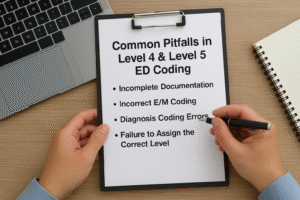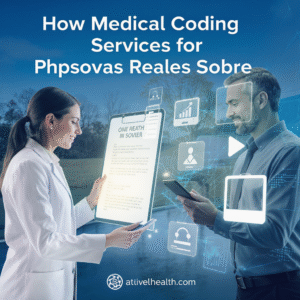How Accurate Coding Improves Patient Satisfaction & Revenue: The Hidden Connection That Drives Healthcare Success
Accurate Coding
Accurate Coding
In the complex ecosystem of healthcare, medical coding often operates behind the scenes, invisible to patients but fundamental to the entire healthcare experience. While patients may never directly interact with medical coders, the accuracy of coding practices creates a ripple effect that significantly impacts both patient satisfaction and organizational revenue. This intricate relationship between precise coding and positive patient outcomes represents one of healthcare’s most underappreciated success factors.

The Foundation: Understanding Medical Coding’s Role
Medical coding serves as the universal language of healthcare, translating complex medical procedures, diagnoses, and treatments into standardized alphanumeric codes. These codes, primarily using ICD-10, CPT, and HCPCS systems, form the backbone of healthcare communication between providers, insurers, and regulatory bodies. However, the impact of coding extends far beyond administrative convenience—it directly influences every aspect of the patient journey.
When coding accuracy reaches optimal levels, healthcare organizations experience improved claim processing, reduced denials, and enhanced compliance with regulatory requirements. More importantly, accurate coding creates a seamless administrative foundation that allows healthcare providers to focus on what matters most: delivering exceptional patient care.
The Direct Impact on Patient Satisfaction
Streamlined Billing Processes
Accurate coding eliminates the confusion and frustration that patients experience when dealing with billing errors. When procedures and diagnoses are coded correctly from the start, insurance claims process smoothly, reducing the likelihood of unexpected bills or coverage denials that patients must navigate. This transparency in billing creates trust between patients and healthcare providers, as patients can better understand their financial responsibilities upfront.
The psychological impact of clear, accurate billing cannot be overstated. Patients who receive confusing or incorrect bills often experience stress and anxiety that can overshadow their satisfaction with the clinical care they received. By ensuring coding accuracy, healthcare organizations protect patients from these unnecessary administrative burdens.
Reduced Administrative Burden on Patients
When coding is accurate, patients spend significantly less time on the phone with insurance companies, billing departments, and healthcare providers trying to resolve discrepancies. This reduction in administrative hassle allows patients to focus on their health and recovery rather than navigating complex billing issues. The time and energy saved translate directly into improved patient experience and satisfaction scores.
Furthermore, accurate coding minimizes the need for patients to provide the same information repeatedly to different departments within the healthcare system. This efficiency demonstrates respect for patients’ time and creates a more professional, organized impression of the healthcare facility.
Enhanced Care Coordination
Precise coding facilitates better communication between healthcare providers, specialists, and insurance companies regarding a patient’s condition and treatment plan. When medical information is accurately coded and transmitted, it reduces the likelihood of miscommunication that could delay treatment approvals or create confusion about covered services.
This improved coordination means patients experience fewer delays in receiving necessary treatments, smoother transitions between providers, and more comprehensive care management. The result is a healthcare experience that feels cohesive and well-managed, directly contributing to patient satisfaction.

The Revenue Connection: How Accuracy Drives Financial Success
Maximized Reimbursement Rates
Accurate coding ensures that healthcare organizations capture the full value of the services they provide. When procedures and diagnoses are coded with precision, claims are processed at the correct reimbursement level, preventing revenue loss from under-coding. This accuracy is particularly crucial for complex procedures or cases involving multiple diagnoses, where coding precision can significantly impact reimbursement amounts.
Healthcare organizations that maintain high coding accuracy rates typically see a measurable increase in their average reimbursement per claim. This improvement stems not from gaming the system, but from ensuring that the complexity and intensity of care provided are accurately reflected in the coding.
Reduced Claim Denials and Appeals
Insurance companies deny claims for various reasons, but coding inaccuracies represent one of the most preventable causes. When coding is accurate and complete, the initial claim approval rate increases dramatically, reducing the time and resources spent on appeals and resubmissions. This efficiency improvement has a direct impact on cash flow, as organizations receive payments faster and with less administrative overhead.
The cost of managing denied claims extends beyond the delayed payment. Healthcare organizations must invest staff time and resources in researching, correcting, and resubmitting claims. Accurate initial coding eliminates much of this waste, allowing resources to be redirected toward patient care or other revenue-generating activities.
Compliance and Risk Mitigation
Accurate coding significantly reduces the risk of compliance violations and potential audits by regulatory bodies and insurance companies. Healthcare organizations with strong coding accuracy records face fewer regulatory challenges and avoid the substantial costs associated with compliance violations, including fines, penalties, and the expensive process of remediation.
The financial impact of compliance issues extends beyond immediate penalties. Organizations facing regulatory scrutiny often experience disrupted operations, damaged reputations, and increased oversight that can affect their ability to attract patients and maintain partnerships with insurance providers.

The Synergistic Effect: Where Satisfaction and Revenue Intersect
Building Trust Through Transparency
The relationship between patient satisfaction and revenue becomes most apparent in the trust that accurate coding builds with patients. When patients consistently receive clear, accurate bills and experience smooth insurance processing, they develop confidence in the healthcare organization’s competency and integrity. This trust translates into patient loyalty, positive word-of-mouth referrals, and higher patient retention rates.
Satisfied patients are more likely to return for future healthcare needs and recommend the organization to family and friends. In an increasingly competitive healthcare market, this organic growth through patient satisfaction provides a sustainable competitive advantage that directly impacts long-term revenue.
Operational Efficiency Gains
Accurate coding creates operational efficiencies that benefit both patients and the organization’s bottom line. When claims process smoothly, administrative staff can focus on patient service rather than error correction. This improved efficiency often results in shorter wait times, better customer service, and more responsive patient support—all factors that contribute to patient satisfaction.
From a financial perspective, these operational improvements reduce staffing costs in billing and administrative departments while potentially increasing patient volume through improved service delivery. The cost savings from reduced administrative overhead can be reinvested in patient care improvements or facility enhancements.
Data-Driven Quality Improvements
Accurate coding provides healthcare organizations with reliable data about patient populations, treatment outcomes, and resource utilization. This data enables evidence-based decision-making about service offerings, staffing levels, and quality improvement initiatives. When organizations can accurately track and analyze their patient care data, they can identify opportunities to enhance both patient satisfaction and operational efficiency.
The insights gained from accurate coding data help healthcare organizations anticipate patient needs, optimize resource allocation, and develop targeted improvements that address specific patient satisfaction challenges while maintaining financial sustainability.
Implementing Excellence: Best Practices for Coding Accuracy
Investment in Education and Training
Healthcare organizations serious about improving coding accuracy must invest in comprehensive education and ongoing training for their coding staff. This investment includes not only initial certification training but also regular updates on coding changes, clinical documentation improvement, and emerging healthcare technologies that affect coding practices.
The return on investment in coding education is measurable through improved accuracy rates, reduced denials, and enhanced revenue capture. Organizations that prioritize coding education often see improvements in both patient satisfaction metrics and financial performance within the first year of implementation.
Technology and Automation Solutions
Modern healthcare organizations increasingly rely on technology solutions to support coding accuracy, including computer-assisted coding software, automated claim scrubbing systems, and integrated electronic health record platforms that facilitate accurate code selection. These technological investments help reduce human error while improving coding efficiency and consistency.
The implementation of coding technology solutions requires careful planning and staff training, but the long-term benefits include improved accuracy, faster claim processing, and enhanced ability to track and analyze coding performance metrics.

Quality Assurance and Continuous Improvement
Establishing robust quality assurance processes for coding accuracy ensures that high standards are maintained consistently over time. This includes regular internal audits, peer review processes, and performance monitoring systems that identify areas for improvement before they impact patient satisfaction or revenue.
Continuous improvement in coding accuracy requires a culture of accountability and excellence throughout the healthcare organization. When coding accuracy is recognized as a strategic priority that affects both patient care and financial performance, organizations can achieve sustainable improvements in both areas.
Measuring Success: Key Performance Indicators
Healthcare organizations should track specific metrics to assess the impact of coding accuracy on patient satisfaction and revenue. These metrics include first-pass claim approval rates, patient billing inquiry volume, patient satisfaction scores related to billing and administrative processes, and net revenue per adjusted admission.
Regular monitoring of these indicators allows organizations to identify trends, celebrate successes, and address challenges proactively. The correlation between coding accuracy improvements and positive changes in these metrics provides concrete evidence of the value created by investing in coding excellence.
Conclusion: The Strategic Imperative
The connection between accurate coding and improved patient satisfaction and revenue represents a strategic opportunity for healthcare organizations to create value for both patients and stakeholders. By recognizing coding accuracy as more than an administrative function—viewing it instead as a critical component of patient experience and financial performance—healthcare leaders can drive meaningful improvements in both areas simultaneously.
The investment required to achieve coding excellence pays dividends through improved patient loyalty, enhanced operational efficiency, and optimized revenue capture. In an era where healthcare organizations face increasing pressure to improve both patient outcomes and financial sustainability, accurate coding provides a practical pathway to achieving both goals.
Healthcare organizations that embrace this understanding and commit to coding excellence position themselves for long-term success in an increasingly competitive and complex healthcare environment. The hidden connection between coding accuracy and organizational success is hidden no more—it represents one of healthcare’s most powerful opportunities for sustainable improvement.



